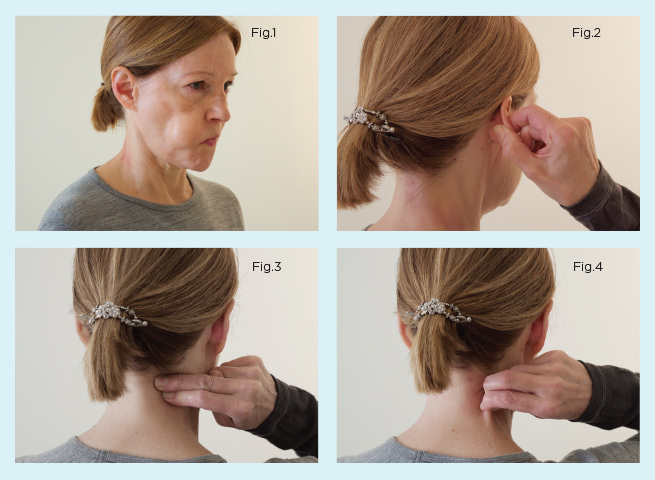Tight Neck and Shoulders?
 by Ginette Séguin-Swartz, Certified Antigym® Practitioner & Trainer by Ginette Séguin-Swartz, Certified Antigym® Practitioner & Trainer
At the end of the day, are your shoulders tense, is your neck sore? Do you feel like you are carrying the weight of the world on your shoulders? Release the tension with these simple, yet powerful Antigym® movement sequences.
Anti… what? Antigym, created in the mid-1970s by French physiotherapist Thérèse Bertherat, author of the international best-seller The Body Has Its Reasons, is consciousness in action. It is the opposite of repetitive, mindless body training. The small, slow, and precise movement sequences are designed to release muscle tension, realigning the body and bringing back flexibility and ease of movement. Participants execute the movements at their own pace, with as much, or as little, intensity as they choose. Emphasis is placed on sensing what is happening in the body, on becoming aware of the sensations generated by the movements.
Here are three movement sequences designed to release tense neck and shoulders. You can do the movement sequences either sitting or standing. Remove your shoes. Your feet are flat on the floor, slightly apart and parallel. If sitting, sit squarely on your sitting bones, back straight.

Sequence 1. Open and close your mouth slowly, without effort, 8–10 times. Your lips are soft. As you open and close your mouth, perhaps you can hear clicking, popping sounds coming from the articulations of your jaw.
Now, with your mouth ajar and your tongue wide, relaxed on the floor of your mouth, pay attention to the air moving in and out of your body as you breathe. Inhale through your nose and exhale through your mouth. Silently. Feel the coolness of the air as it enters your nose and the warmth of your breath as it flows out of your mouth. Continue breathing like this for 8–10 breaths.
Now angle your tongue towards your right cheek. With the tip of your tongue, explore the inside of your right cheek, from top to bottom, from the front to the back, as if you were scanning the inside of your cheek. Now touch the centre of your right cheek with the tip of your tongue. And with the tip of your tongue, push your cheek out (Fig.1). Your cheek is totally passive. From the outside, it looks like you have a big piece of candy in your cheek. When your tongue stops pushing, its tip remains in contact with your cheek. Repeat 10–12 times. Continue 10–12 more times with the breath, exhaling when your tongue pushes your cheek, and inhaling when you stop pushing. Then let your tongue rest on the bottom of your mouth. Take a moment to observe how your mouth, the right side of your face, and the right side of your neck feel.
Sequence 2. Feel the shape of your right ear with your right hand. Elbow facing forward, gently hold the earflap between your thumb and index finger and gently pull your ear back and out (Fig.2), then stop pulling. Repeat 10–12 times with the breath: gently pull your ear on the exhalation and stop pulling on the inhalation. Your mouth stays ajar. Now release your arm alongside your body. Take a moment to observe how the right side of your face, the right side of your neck, and your right shoulder feel.
Sequence 3. Elbow forward, place two fingers of your right hand on the nape of your neck in the middle, at the hairline. Feel the small hollow area at the base of your head. To the right of this area, you can feel a thick band. Starting near your hair, slide your fingers down slowly along this band, pressing gently with your fingertips (Fig.3). Do this very slowly, as if your intent was to lengthen the right side of your neck. When you reach your upper back, lift your hand off your neck and bring it back near your hair and slide your fingers down again. Repeat 10–12 times. Keep your mouth ajar and your jaws relaxed. Now bring your right hand back to the top of your nape, near your hair. Elbow forward, try to grab the right side of your nape between the thumb and 1–2 fingers (Fig.4). Gently pull the skin and the muscles when you exhale. When you inhale, stop pulling but keep holding the skin and the muscles. Imagine that you are trying to create breathing room in the back of your neck. Repeat 4–5 times. Now move your fingers down 1 cm or so, grab the skin and the muscles, and pull when you exhale, and stop pulling when you inhale. Repeat 4–5 times. Continue to go down your neck cm by cm, taking your time. Now, release your arm alongside your body. Take a moment to observe the right side of your neck. How does it feel relative to the other side? How do your right shoulder, your right arm feel relative to your left shoulder, your left arm? If you are standing, how does the right foot feel relative to the left? Turn your head slowly to the right and return it slowly to centre. And now, turn your head to the left. Compare the range of motion of your head between right and left. Repeat the sequence on the left if desired. With Antigym, there is no need to do both sides. The left side learns from the right!
Ginette Séguin-Swartz has been teaching Antigym in Saskatoon since 2004 and training Antigym practitioners since 2008. For information on free Antigym classes offered in Saskatoon and Regina during Antigym Awareness Week (September 5–11, 2017), please see the Calendar of Events ad on page 5 of the 23.2 July/August issue of the WHOLifE Journal. |
